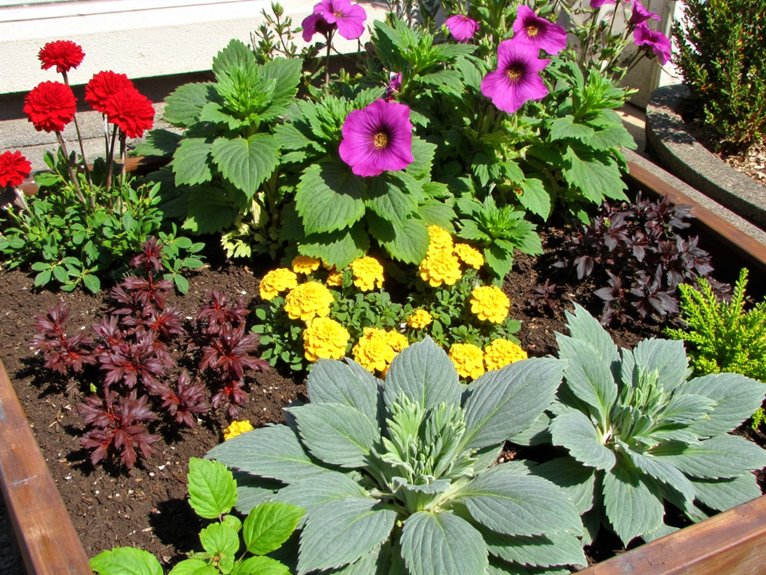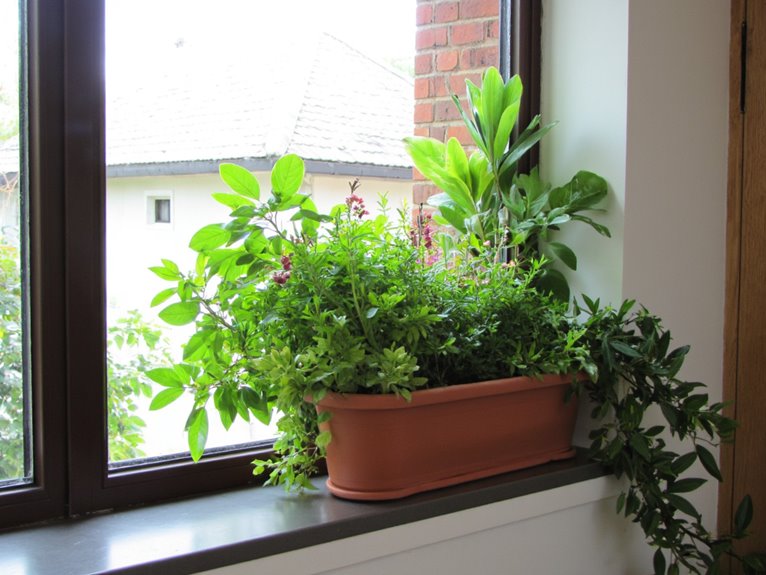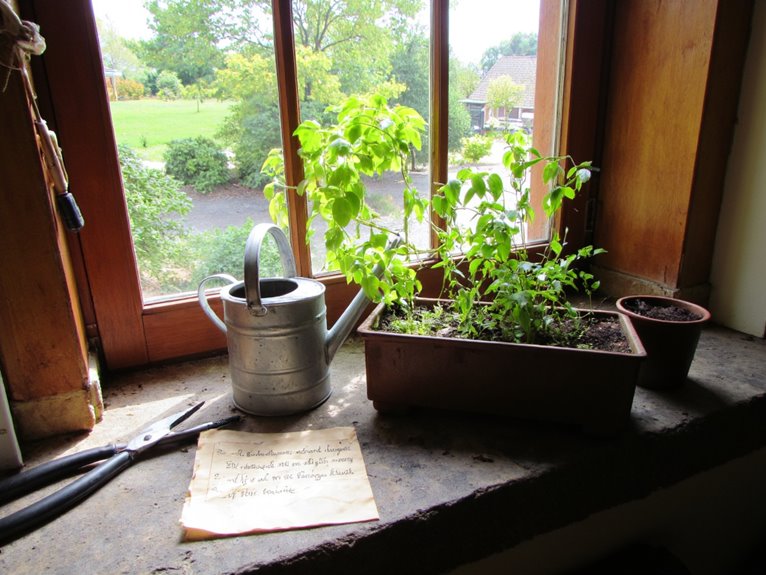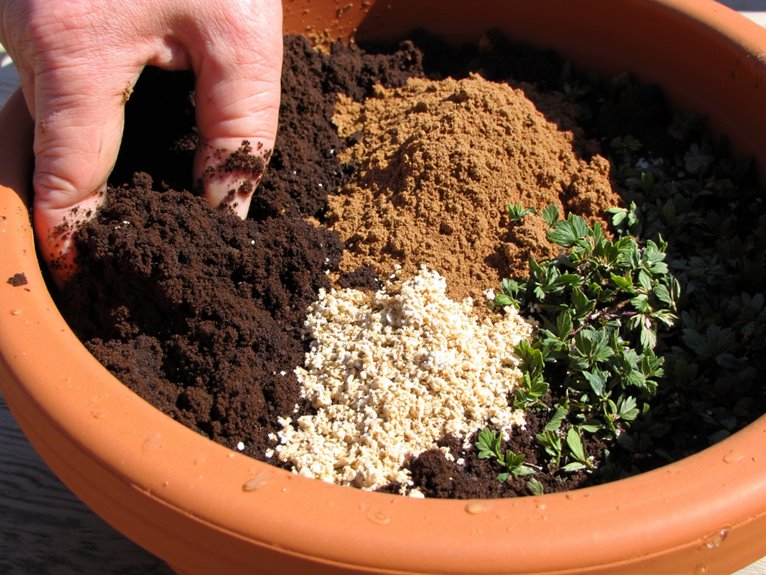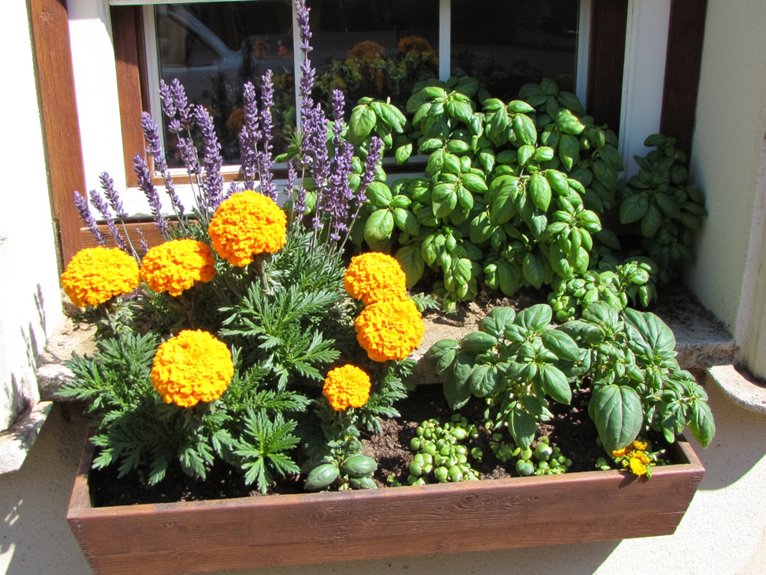Window Box Garden Soil Requirements: Proper Potting Mix for Confined Container Growing
A great window box garden needs a lightweight potting mix with good drainage and aeration. Use organic materials like peat moss, compost, and coconut coir for water retention and nutrients. Add perlite or vermiculite to prevent waterlogging and keep roots healthy. Avoid topsoil, which can compact and drown plants. Fertilize regularly with water-soluble feeds to replace what gets washed away. Keep the soil pH between 6.0 and 7.0 for best growth. With the right mix, your window box will bloom beautifully all season long—just remember, there’s more tips waiting to help you master container gardening.
Notable Insights
- Use lightweight potting mix with perlite for drainage and aeration in window boxes.
- Avoid topsoil to prevent compaction, waterlogging, and weed introduction.
- Maintain pH 6.0–7.0 with organic amendments like compost or peat moss.
- Fertilize regularly with water-soluble or slow-release options due to limited soil volume.
- Add vermiculite for moisture retention and balance the mix for healthy plant growth.
Essential Components of a High-Quality Potting Mix
A quality potting mix forms the foundation of any successful container garden. Start with organic amendments like sphagnum peat moss or coconut coir for water retention and aeration. Add aged bark or compost to improve texture and nutrient content. For drainage, incorporate inorganic amendments such as perlite or coarse sand—these prevent compaction while maintaining lightness. Avoiding heavy soils like topsoil Balance these components carefully based on your plants’ needs; too much of either can hinder growth. Target a pH range between 6.0 and 7.0 to support faster root development and enhance nutrient uptake for healthier plant growth. A well-crafted mix guarantees roots thrive, flowers bloom, and your window box garden stays vibrant all season long.
Why Topsoil Should Be Avoided in Window Boxes
Although you might be tempted to use garden topsoil in your window boxes, doing so can actually harm your plants’ chances of thriving. Topsoil’s fine particles compact tightly, blocking air spaces and water drainage essential for container suitability. This creates waterlogged conditions prone to root rot and moss growth. Additionally, undecomposed organic matter consumes nitrogen, starving plants in limited spaces. Topsoil also risks spreading weeds and pathogens unsuitable for confined gardens. Poor aeration undermines root development, making lightweight potting mixes that provide better air circulation essential for healthy container plants. Premium organic mixes enhance moisture retention while providing proper drainage needed for container growing success. Explore topsoil alternatives like peat moss or coconut coir to create ideal conditions for your window box plants to flourish.
Creating the Perfect Drainage System With Perlite and Vermiculite
After learning why topsoil can be problematic in confined spaces like window boxes, you might wonder how to create a well-draining mix that supports healthy root growth. Perlite and vermicutite offer ideal solutions for drainage efficiency and moisture balance. Perlite’s porous structure improves aeration and prevents waterlogging, while vermiculite retains moisture without causing saturation. For window boxes, aim for 20-30% perlite to enhance drainage efficiency and prevent root rot. Add 15-25% vermiculite to maintain moisture balance during dry periods. Combine equal parts with peat moss for a lightweight mix. Layer coarse perlite at the base of deeper boxes. The lightweight volcanic mineral properties of perlite make it particularly effective for preventing soil compaction in container environments. Adjust ratios based on your plants’ needs – more perlite for rainy seasons, more vermiculite for arid climates. This balance guarantees roots receive oxygen and water without excess moisture stress. Drainage optimization is particularly important in containers where water can pool and lead to fungal issues.
Maintaining Nutrient Levels Through Regular Fertilization
While container gardens offer beautiful displays, maintaining consistent nutrient levels can be tricky due to frequent watering and limited soil volume. Regular fertilization compensates for leaching and supports lush growth. Let’s explore fertilizer types and timing:
| Fertilizer Type | Application Frequency | Key Nutrients |
|---|---|---|
| Water-soluble | Every 1-2 weeks | N, P, K |
| Slow-release granules | Monthly | Balanced NPK |
| High-P/K bloom boosters | Every 3 weeks | P, K for flowers |
Choose based on plant needs. Monitor nutrient levels through leaf color and growth rates – yellowing signals deficiencies while burnt edges suggest over-fertilization. Start feeding 2-6 weeks after planting and adjust as needed throughout the growing season.
Adjusting Soil Ph for Optimal Plant Health
When it comes to container gardening, getting your soil just right isn’t just about what you add—it’s also about the subtle balance of acidity and alkalinity that affects everything from nutrient uptake to root health. The Soil pH determines Nutrient Availability, fastening or releasing essential elements for plant use. Most window box plants thrive in slightly acidic to neutral soils (pH 6–7), but some like blueberries need much lower levels. Regular testing helps you spot imbalances early and make adjustments with amendments like lime or sulfur. Don’t forget that container materials and watering sources can also shift pH over time, requiring ongoing care. By mastering this balance, you’ll watch your plants flourish with vibrant growth and abundant harvests.
Techniques for Lightweight Container Gardening
Although window boxes are small spaces, their success depends on thoughtful soil selection and container design. Lightweight container gardening starts with soilless mixes containing peat moss, perlite, and vermiculite—these reduce container weight while improving aeration. To further cut weight, fill deep containers halfway and add foam blocks or plastic bottles as filler options. Opt for plastic or fabric pots instead of heavy ceramic varieties. By prioritizing container weight reduction and smart filler choices, you’ll create easier-to-move, healthier plant environments perfect for confined spaces.
Choosing the Right Compost for Container Plants
One of the best ways to nourish container plants is with high-quality compost, which provides essential nutrients while improving soil structure. When choosing compost types, opt for peat-free multipurpose mixes or blend chicken manure-rich compost with soilless materials for ideal aeration. Nutrient availability in containers depends on microbial activity that converts organic matter into plant-accessible forms. Avoid pure compost alone, as it risks compaction—mix it with perlite or coir instead. Regularly replenish compost to maintain fertility, especially in smaller pots where nutrients deplete faster. A well-balanced mix supports healthy growth without the weight issues of topsoil.
Preventing Waterlogging in Small Spaces
Whether you’re cultivating herbs on a sun-drenched windowsill or growing flowers in compact containers, preventing waterlogging is key to keeping plants thriving rather than drowning. Drainage techniques like holes, layered materials, and proper potting mixes help avoid root rot by letting excess water escape. Pots need drainage holes to prevent water from pooling around roots, while gravel layers and geo-fabrics create pathways for drainage without compacting soil. Lightweight potting mixes with perlite or vermiculite improve aeration and reduce compaction risks. For pots without holes, manual watering followed by tipping helps remove standing water temporarily. By prioritizing drainage, you’ll keep roots healthy and plants happy in even the smallest spaces.
Refreshing Soil for Continuous Harvests
After ensuring your window box drains properly, keeping plants thriving goes beyond just watering – it requires periodic soil refreshes. By practicing crop rotation, you prevent nutrient depletion and pest buildup, ensuring your garden stays productive year-round. Regular soil monitoring helps identify when amendments are needed, maintaining ideal growing conditions. To refresh, remove old plants, test the soil for pH and nutrients, then mix in compost or organic fertilizers as required. This process supports continuous harvests through succession planting, allowing you to maximize space and extend your garden’s productivity. Remember to clean containers thoroughly before refilling, creating a fresh start for your next season’s crops.
Sustainable Practices for Window Box Gardening
Although window boxes are compact spaces, they offer opportunities for sustainable gardening practices that benefit both plants and the planet. Choose containers from sustainable materials like recycled plastic or durable composites to cut waste while ensuring proper drainage. For soil, mix organic compost with nutrient-rich potting soil to create a thriving ecosystem. Integrate biodiversity by planting native species that support pollinators and provide year-round habitat. Water wisely with drip systems or mulch to conserve resources, and rotate crops to maintain soil health. These practices transform small spaces into environmentally friendly gardens that flourish sustainably.
Frequently Asked Questions
What Causes Root Rot in Window Boxes?
Root rot in window boxes stems from overwatering issues and fungal infections. Excess moisture suffocates roots, while poor drainage traps water, creating an ideal environment for fungi to thrive and destroy your plants.
Is Homemade Compost Safe for Container Plants?
Is homemade compost safe for container plants? Yes, when properly made and matured, but avoid green piles that might attract pests or harbor weed seeds. Make sure it smells earthy, not sour or foul.
How Do I Fix Nutrient Deficiency in Potted Herbs?
You can fix nutrient deficiencies by using balanced fertilizer types and adding nutrient sources like compost or Epsom salts. Regular feeding helps since containers deplete fast, and checking pH guarantees plants absorb what they need.
Can I Reuse Soil After a Growing Season?
Yes, you can reuse soil after a growing season, but it’s best to do some soil sterilization first. Check container drainage and add compost or fertilizer to restore nutrients. Avoid reusing soil with pests or diseases.
What’s the Best Way to Harden off Seedlings Outdoors?
The best way to harden off seedlings is by starting ten days before transplanting and gradually exposing them to outdoor conditions. Begin with shade, warm temperatures above 45°F, and short sessions, then increase time each day. Protect from wind, cold, and pests. This outdoor acclimation helps seedlings adjust before planting.
On a final note
With the right mix of compost, perlite, and nutrients, your window box can thrive year after year. Regular feeding and careful watering will keep plants healthy and happy in their confined space. Don’t forget to refresh the soil annually to maintain fertility and prevent buildup of salts or pests. By following these simple guidelines, you’ll enjoy fresh herbs, flowers, and even small vegetables right at your fingertips—no garden plot required.
(75 words)

